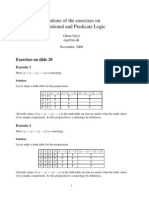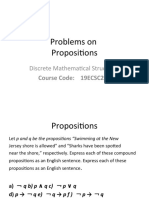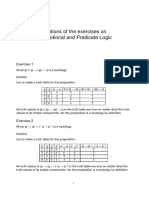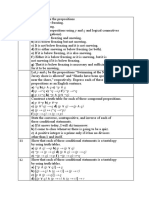0 ratings0% found this document useful (0 votes)
47 viewsObjective Current Lab Learning Outcomes (LLO)
This lab covers propositional equivalences. Students will work in groups to solve examples showing that logical statements are tautologies, contradictions, or equivalent using rules of propositional logic. Examples include showing that ¬(p ∨ ¬(p ∧ q)) is a contradiction, [(p ∨ q) ∧ (p → r) ∧ (q → r)] → r is a tautology, and that ¬(p∨(¬p∧q)) and (¬p ∧ ¬q) are equivalent. Students are allowed to use their lecture notes and will discuss their answers with the instructor.
Uploaded by
aoora6Copyright
© © All Rights Reserved
Available Formats
Download as PDF, TXT or read online on Scribd
0 ratings0% found this document useful (0 votes)
47 viewsObjective Current Lab Learning Outcomes (LLO)
This lab covers propositional equivalences. Students will work in groups to solve examples showing that logical statements are tautologies, contradictions, or equivalent using rules of propositional logic. Examples include showing that ¬(p ∨ ¬(p ∧ q)) is a contradiction, [(p ∨ q) ∧ (p → r) ∧ (q → r)] → r is a tautology, and that ¬(p∨(¬p∧q)) and (¬p ∧ ¬q) are equivalent. Students are allowed to use their lecture notes and will discuss their answers with the instructor.
Uploaded by
aoora6Copyright
© © All Rights Reserved
Available Formats
Download as PDF, TXT or read online on Scribd
You are on page 1/ 3
Lab 03 Propositional Equivalences
Objective
Solving exercises from the textbook in chapter 1.3
Current Lab Learning Outcomes (LLO)
By completion of the lab, the students should be able to:
1. Understand propositional equivalences and .
2. prove the propositional equivalences using rules
Lab Requirements
Students allowed using their lecture notes in the lab in order to solve the exercises.
Lab Assessment
1- Divide students to groups and let them to solve the given example.
2- Discuss the answers with the groups and write on board the optimal solution.
Lab Description
1. Show that ¬(p ∨ ¬(p ∧ q)) is contradiction using rules.
2. show that [(p ∨ q) ∧ (p → r) ∧ (q → r)] → r is a tautology using rules
3. Show that [p ^ (p → q)] → q is a tautology using rules
4. Show that [¬p ∧ (p ∨ q)] → q is a tautology using rules.
5. Show that ¬ p→ (q → r) and q →( p v r) are logically equivalent using rules.
6. Show that ¬p ↔ q and p ↔ ¬q are logically equivalent using rules
¬p ↔ q ⇔ (¬p→q) ∧ (q→¬p) Biconditional
= (¬¬p∨q) ∧ (¬q∨¬p) Implication
= (p∨q) ∧ (¬q∨¬p) Double Negation
= (q∨p) ∧ (¬p∨¬q) Commutative
= (¬¬q∨p) ∧ (¬p∨¬q) Double Negation
= (¬q→p) ∧ (p→¬q) Implication
= (p→¬q) ∧ (¬q→p) Commutative
= p ↔ ¬q Biconditional
7. Determine whether¬(p∨(¬p∧q)) and (¬p ∧ ¬q) equivalent using rules?
¬(p∨(¬p∧q)) =¬p ∧ ¬(¬p∧q) DeMorgan
=¬p ∧ (¬¬p∨¬q) DeMorgan
=¬p ∧ (p∨¬q) Double Negation
=(¬p∧p)∨(¬p ∧¬q) Distribution
=(p∧¬p)∨(¬p ∧¬q) Commutative
=F ∨(¬p ∧¬q) Negation
= (¬p ∧¬q) ∨ F Commutative
= (¬p ∧¬q) Identity
¬(p∨(¬p∧q)) and (¬p ∧ ¬q) equivalent
You might also like
- The Foundations: Logic and Proofs Kenneth H. Rosen 7 EditionNo ratings yetThe Foundations: Logic and Proofs Kenneth H. Rosen 7 Edition17 pages
- Objective Current Lab Learning Outcomes (LLO) : NooraNo ratings yetObjective Current Lab Learning Outcomes (LLO) : Noora3 pages
- Section 1.2, Selected Answers Math 114 Discrete MathematicsNo ratings yetSection 1.2, Selected Answers Math 114 Discrete Mathematics2 pages
- Assignment 1: Discrete Structure BS (CS) Propositional Logic 13th March 2022No ratings yetAssignment 1: Discrete Structure BS (CS) Propositional Logic 13th March 20221 page
- Logical Equivalences - Discrete Mathematics Questions and Answers - SanfoundryNo ratings yetLogical Equivalences - Discrete Mathematics Questions and Answers - Sanfoundry7 pages
- Solutions of The Exercises On Propositional and Predicate LogicNo ratings yetSolutions of The Exercises On Propositional and Predicate Logic8 pages
- Lecture 3: Propositional Equivalences: Zeph GrunschlagNo ratings yetLecture 3: Propositional Equivalences: Zeph Grunschlag46 pages
- CPT 317 - AI Week 7 PL FOL (Question and Answer)No ratings yetCPT 317 - AI Week 7 PL FOL (Question and Answer)9 pages
- P: It Is Below Freezing. Q: It Is SnowingNo ratings yetP: It Is Below Freezing. Q: It Is Snowing2 pages
- w01 Tutorial Propositional Logic SolutionsNo ratings yetw01 Tutorial Propositional Logic Solutions7 pages
- Truth Tables Tautologies&Logicall Equivalent StatementsNo ratings yetTruth Tables Tautologies&Logicall Equivalent Statements5 pages
- Module 2c - Logical Equivalence and Forms of Conditional PropositionsNo ratings yetModule 2c - Logical Equivalence and Forms of Conditional Propositions4 pages



























































